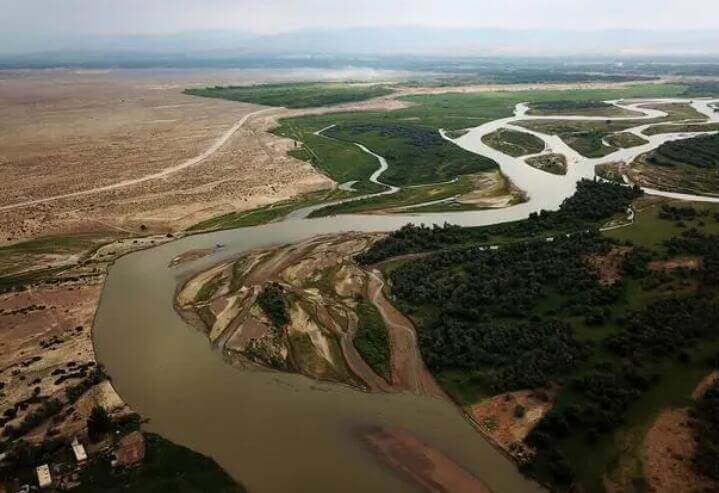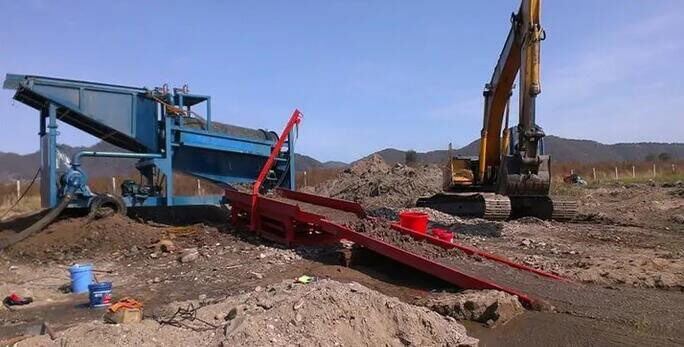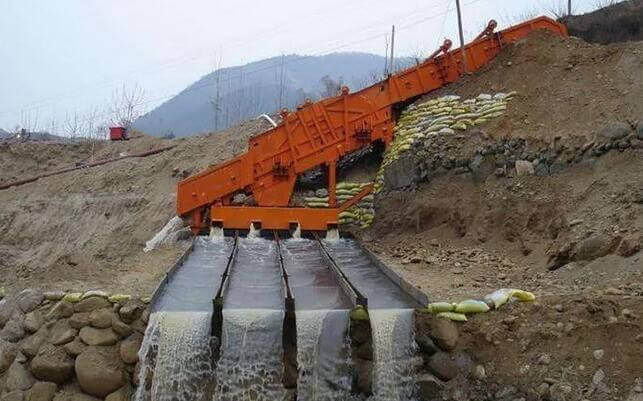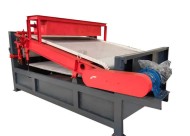Placer gold deposits are formed through the erosion, transport, and deposition of gold particles in water. They typically occur in riverbeds, alluvial fans, and other sedimentary environments.
Formation of Placer Gold Deposits
Erosion and Weathering
Gold is released from primary gold-bearing rocks through weathering and erosion processes, breaking down the host rocks and freeing gold particles.
Transportation by Water
Gold particles are transported by water, often in rivers or streams. Water flow, especially during periods of high energy such as floods, can carry gold particles over distances.
Deposition
Gold particles settle and accumulate due to their higher density when the water velocity decreases, such as in riverbeds or sedimentary basins. The deposition of gold in these areas leads to the forming of placer gold deposits.
Classification of Placer Gold Deposits
Placer gold deposits are widely distributed and of various types. They can usually be divided into the following types:
- Alluvial Placers: These are the most common type of placer gold deposits. Gold particles are deposited by water in riverbeds, floodplains, and deltas. Alluvial placers, such as rivers, benches, and floodplains, can be further classified based on location.
- Eluvial Placers: Gold is concentrated in place over the source rock due to weathering and decomposition. This type of placer deposit is often found on hillsides and slopes.
- Beach Placers: Gold accumulates on beaches due to the action of waves and tides. The high density of gold allows it to settle out of the lighter beach sands.
- Glacial Placers: These deposits result from the transport of gold by glaciers. As glaciers move over the landscape, they can pick up and transport gold particles, depositing them as the glacier melts.
- Residual Placers: Gold is concentrated in soils and weathered rock material overlying its source bedrock. This type of placer deposit is often found in regions with intense weathering.
- Bench Placers: Gold accumulates on elevated terraces or benches along riverbanks, often formed during changes in the course of the river.
- Stream Placers: Gold is deposited in the active stream channel, often associated with meanders and bedrock exposures.
According to the main mineral types contained in the deposit, placer gold deposits can be divided into:
- Mixed Placer Deposit: Contains various minerals and metals, such as gold, silver, tin, iron, etc., mixed to form placer gold.
- Gold Placer Deposit: Mineral sand mainly contains gold particles. This is the most common type of gold placer deposit, sometimes called a gold placer bed.
- Magnetite Placer Deposit: Contains magnetite and gold sand. Due to the magnetism of magnetite, it can be separated by magnetic separation and other methods.
- Tin Placer Deposit: Contains tin ore and gold sand, of which the tin ore may be cassiterite, cassiterite, etc.
- Uranium Placer Deposit: Contains uranium ore and gold sand. This type of deposit is common in areas containing uranium ores.
- Ilmenite Placer Deposit: It contains ilmenite ore and gold sand, in which ilmenite ore is mainly composed of sulfite and ilmenite.
- Heavy Mineral Placer Deposit: Contains denser minerals, such as gold, magnetite, tin ore, etc. These minerals will be enriched due to density differences during the deposition process.
The classification of placer gold deposits helps geologists and miners understand the geological context and characteristics of the deposit, aiding in developing effective extraction and processing methods. Each type of placer deposit may require different mining techniques and equipment.
Placer Gold Mining
Placer gold mining involves extracting gold from loose, unconsolidated sediments such as gravel, sand, and silt deposited by natural forces like water. This type of mining is commonly associated with rivers, streams, and alluvial deposits. Placer gold mining has been practiced for centuries and is still a significant method of gold recovery worldwide. Here is an overview of the key aspects of placer gold mining:
1. Exploration
Geological Assessment: Understanding the geology of an area is crucial for identifying potential placer gold deposits. Geologists examine the history of the region, rock formations, and the presence of indicators like quartz veins.
Topographic Maps: Analyzing topographic maps helps identify potential locations for placer gold deposits based on the flow of rivers and streams.
2. Site Preparation
Access and Infrastructure: Establishing access to the mining site and creating the necessary infrastructure, such as roads and camps, is an important initial step.
3. Prospecting
Panning: Traditional panning involves manually washing sediment in a pan to separate gold from other materials.
Sluice Boxes: Sluice boxes use flowing water to separate gold particles from gravel and sand, with riffles capturing the heavier gold.
4. Mining Methods
Open-Pit Mining: Larger-scale operations may use open-pit mining techniques to access placer deposits beneath the surface.
Dredging: Mechanical dredges are used in rivers and streams to extract sediment, separate gold, and dispose of waste material.
Hydraulic Mining: High-pressure water jets are used to dislodge and transport sediments. This method has environmental concerns and is less commonly used today.
5. Processing
Washing Plants: Larger-scale operations use trommels and vibrating screens to process large volumes of material efficiently.
Centrifuges: Centrifugal concentrators separate gold from lighter materials through centrifugal force.
Mercury Amalgamation: Historically used but discouraged due to environmental concerns, mercury can be used to amalgamate with gold particles.
6. Environmental Considerations
Reclamation: Responsible mining operations include plans for site reclamation to restore the environment after mining activities cease.
Water Management: Proper water management is essential to prevent environmental degradation and protect aquatic ecosystems.
7. Regulations and Permits
Compliance: Placer gold mining operations must adhere to environmental regulations and obtain necessary permits from regulatory authorities.
8. Gold Refining
Refining Facilities: Gold may undergo further refining processes after extraction to achieve high purity.
9. Market Sales
Gold Sales: Refined gold is sold to the market, contributing to the global supply.
Placer gold mining can range from small-scale, artisanal operations to larger commercial ventures. Modern practices prioritize environmentally sustainable methods and adhere to regulatory frameworks. It’s important to note that the specific methods and technologies used can vary based on the operation’s scale and the placer deposit’s characteristics. If you are looking for a placer gold mining solution, please contact us to ask for the flow design and equipment.
LATEST PRODUCTS
-
Tubular Screw Conveyor
【Capacity】6-50 m3/h 【Procesible Material】 …
-
Heavy Plate Feeder
Capacity: 100-240 m3/h Power: 15-45 kW Speed: 0…
-
Plate Magnetic Separator
【Capacity】8-35 t/h 【Power】1.5-3 kW 【Applic…












